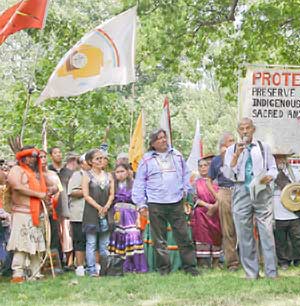‘Longest Walk 2’ demands Native rights, respect of earth
By
Johnnie Stevens
and
Sara Catalinotto
Published Jul 20, 2008 8:48 PM
Two thousand people joined the Longest Walk 2 at the White House in Washington,
D.C., on July 11. This mobilization marks the 30th anniversary of the original
Longest Walk, when thousands of Native Americans converged on the Capitol to
defeat eleven pieces of legislation that would have terminated Native American
tribal rights.
|
Longest Walk 2, July 11.
Photo: Laura Ayers
|
LW2 began in San Francisco on Feb. 11, raising environmental injustice and
global warming, protection of sacred sites, sovereignty, health concerns and
cultural survival. The walk toured 8,000 miles, 26 states and 35 Indian
nations. LW2 took two routes, northern and southern. The northern route was
attacked by police while in Ohio last month. The southern route visited sites
hit by hurricanes Katrina and Rita.
Indigenous people from North, South and Central America and the Pacific
Islands, as well as people from South Africa, Europe, Australia and Asia,
joined the walk. All generations were present, with youth visibly leading
various aspects of the mobilization such as security and press work.
Delegations participated in Washington from the Leonard Peltier Defense
Committee, Black Left Unity, Katrina Rita Diaspora Solidarity Caravan, American
Indian Community House of New York City, All African Peoples’
Revolutionary Party, D.C. Peoples’ Media Center, Black Talk Radio and
WBAI.
After a militant rally led by Longest Walk veterans, including dances and
songs, Dennis Banks, founder of American Indian Movement, thanked everyone for
their help throughout the walk. Dennis repeated the slogan, “All life is
sacred. Clean up mother earth,” referring to walkers who had picked up
thousand of bags of trash along the route.
The crowd grew as the walk picked up tourists and D.C. workers. At the Capitol,
LW2 held a press conference featuring Banks and delegations from each nation on
the walk, artist/activist Harry Belafonte and House Judiciary Chairperson John
Conyers.
Banks presented Rep. Conyers with a Manifesto of Change along with the original
manifesto from the 1978 Longest Walk, which Congress had refused at the time.
The LW2 manifesto is a collection of voices the organizers had heard from
communities across Turtle Island.
One of the sixteen resolutions attached to the manifesto calls on the U.S.
government to free Native American political prisoner Leonard Peltier, whose
frame-up was also an issue in the 1978 Longest Walk. The section titled
“Ongoing Colonization of Mother Earth’s Sacred Places”
addresses in detail the abuse of the land by military testing and by
multinational corporations who take out uranium, coal, copper and trees from
predominantly Native territory and leave behind contaminated water and nuclear
waste dumps. Another section rejects “the occupiers’ borders
imposed on this land,” as well as “NAFTA and other policies [which]
force our people from their land.”
Rep. Conyers thanked all who had joined the walk, saying, “This is the
first struggle—the Indian people.” He acknowledged that past
treaties have always been stepped on by the U.S. government. When Conyers said
he would hold hearings on the LW2 manifesto in a full congressional session,
the crowd erupted. Banks thanked Conyers, saying, “This is the first time
that anyone from the U.S. Congress has acted on any Indian manifesto. This is
already a victory!”
Banks then introduced Belafonte as one of Martin Luther King’s
confidantes and a longtime friend of Indian people. Belafonte thanked Banks for
inviting him to both Longest Walks, 1978 and 2008, and pledged to do all he can
to support the LW2 manifesto.
LW2 continued July 12 at the Lincoln Monument with a Pow-Wow, welcoming all who
were a part of the walk to join in a victory dance. Organizers ask that
supporters stay in touch with their website (www.longestwalk.org) as the
walkers return to their homes.
Articles copyright 1995-2012 Workers World.
Verbatim copying and distribution of this entire article is permitted in any medium without royalty provided this notice is preserved.
Workers World, 55 W. 17 St., NY, NY 10011
Email:
[email protected]
Subscribe
[email protected]
Support independent news
DONATE


